Rohan Nelson, Matthew Miller and Andrew Cameron
A new approach is needed
A challenge for ABARES medium-term forecasts of agricultural markets is that no reliable seasonal climate forecasts exist beyond the current growing season in southern Australia. To date, ABARES has addressed this problem by assuming a return to average seasonal conditions. This assumption poorly reflects the seasonal conditions actually faced by Australia's agricultural industries and it ignores the fact that climate variability has an impact on expected medium-term production. In this edition of Agricultural Commodities ABARES is trialling a scenario approach to provide more realistic insights into the future state of Australian agriculture.
Seasonal climate forecasting in Australian agriculture
The application of seasonal climate forecasts to agricultural projections is a highly developed science in Australia (Hammer, Nicholls & Mitchell 2000, Meinke and Stone 2005). The Australian Bureau of Meteorology routinely produces climate forecasts for the coming season based on leading indicators of climate drivers such as the El Niño Southern Oscillation (Zebiak and Cane 1987), the Indian Ocean Dipole (Ashok et al. 2003) and the Southern Annular Mode (Gillett et al. 2006). These forecasts are most reliable for the 3-month season ahead, but global climate models provide some projections of leading climate indicators out to 9 months. ABARES considers the likely agricultural impacts of these seasonal forecasts and incorporates them into forecasts of Australian and world production for the coming year.
A lack of seasonal climate forecasts beyond the current year means that ABARES must make assumptions about the likely climate conditions in years 2 to 5 of the medium-term projections published in March each year. With no authoritative climate forecasts to rely on for this time horizon, ABARES approach has been to assume a return to average seasonal conditions.
Climate variability is important
Assuming a return to average seasonal conditions is a problematic approach for several reasons. It assumes a 5-year pattern of constant year-to-year average seasonal conditions that Australia's agricultural sector never experiences (Figure 1 ). The mix of drier and wetter years makes a difference to patterns of production and the end point over a given time horizon. Assuming a consistent climate creates a bias that accumulates over the forecast period.
The variability in Australia’s climate is highlighted by the distribution of growing season rainfall across the wheat–sheep zone. In this zone, the climate has been heavily skewed towards low rainfall over the past 20 seasons. (Figure 2 ). When consecutive years of similar climate do occur in recent years, they have tended to be less favourable for agriculture than seasonal conditions averaged over longer 50- to 100-year periods (Figure 1 ). This pattern of climate has been shown to make long-term averages poor forecasts. Pitts (2019), for example, demonstrated that ABARES short-term forecasts of crop production significantly outperform naïve models that use long-term averages.
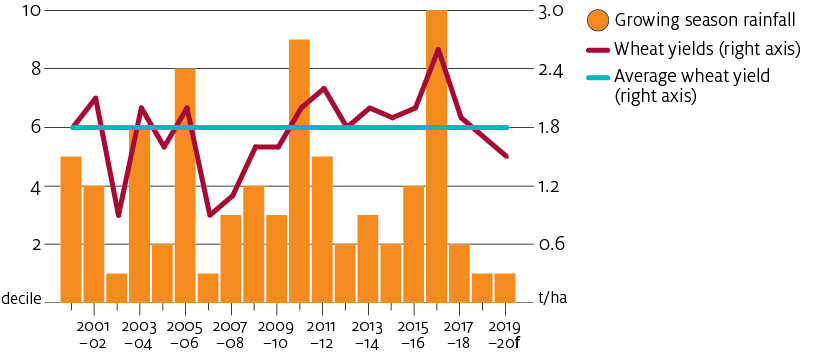
Note: Rainfall deciles are relative to period 1910 to 2019.
Sources: ABARES; BoM
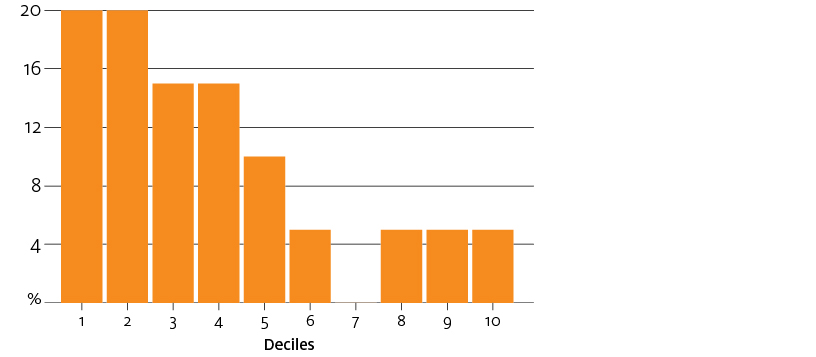
Sources: ABARES; BoM
With climate variability having a material impact on forecasts, implementing a recognition of this in ABARES medium-term forecasts requires a decision around what period climate variability should be drawn from. The Bureau of Meteorology and CSIRO (CSRIO-BOM 2019) found that April to October rainfall across south-eastern and south-western Australia has declined (Figure 3 ) and average temperatures have increased. This means that 50- to 100-year averages are becoming less relevant for forecasting future climate with the last 20 years providing a better indication of climate conditions over the medium term.
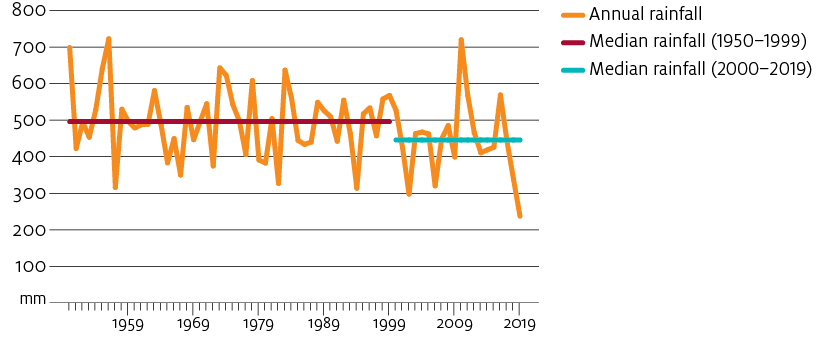
Options for economic analysis
The absence of reliable seasonal climate forecasts beyond the current year forces ABARES to make assumptions about future climate conditions and their effect on agricultural production over the medium term. ABARES aims to make the best possible set of assumptions with the information that is available, and to make these assumptions as explicit as possible so that users can interpret forecasts appropriately. This needs to be achieved using balance sheet models (Ashby 1964), which are poorly equipped for representing the probability of alternative climate scenarios.
The default approach of assuming average seasonal conditions tends to produce forecasts similar to scenarios A and B in Figure 4 for crop production and pasture growth, and restocking scenarios similar to scenario C for livestock production. Scenario A is the least realistic option because it assumes a continuation of current production levels regardless of future climate. Scenarios B (for crop production) and C (for livestock production) are more realistic, but they do not make any allowance for future climate variability. This is problematic because focusing on risk management is one of the primary reasons for producing forecasts (Nelson 2018).
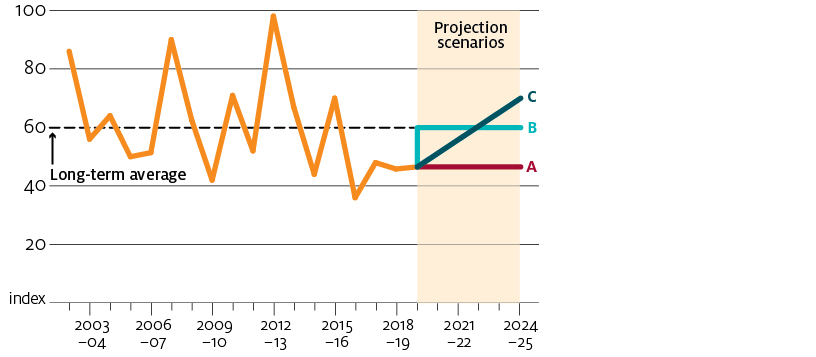
An alternative is to construct scenarios that take into account climate variability and change. ABARES March 2020 medium-term outlook is based on the qualitative climate scenarios described in Figure 5 . Years that would otherwise be assumed to return to average seasonal conditions are now assumed to be somewhat poorer for agriculture, resulting in the kind of production outcomes usually associated with decile 3 or 4 rainfall. The middle year of the projections—2022–23—is assumed to have the production outcomes usually associated with decile 6 or 7 rainfall. In an alternative scenario, the climate in 2022–23 reverts to drought conditions with production outcomes consistent with decile 1 or 2 rainfall.
These are seasonal climate scenarios rather than forecasts of future climatic conditions. They represent seasonal conditions that can reasonably be expected to occur over the next 5 years based on the climate variability and change observed over the last 20 years. This allows ABARES to explicitly communicate the type of impact that climate variability is likely to have on agricultural production over the medium term. These scenarios enable ABARES to avoid the implicit bias that accumulates in production forecasts over the medium term from assuming a constant set of favourable climate conditions for agriculture. In the longer term, seasonal climate forecasts with longer lead times are expected to supersede this approach.
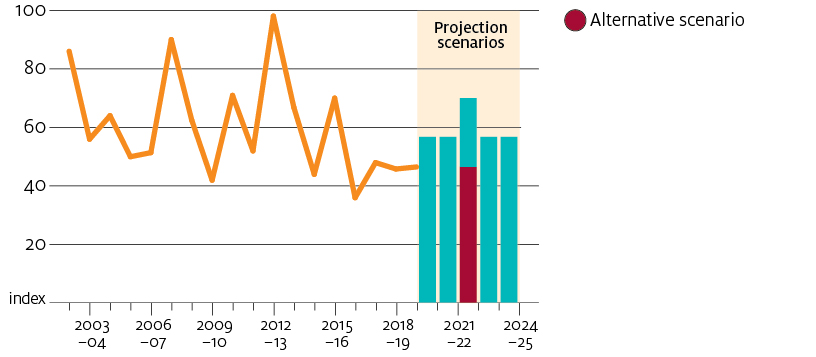
References
Ashby, A 1964, 'On forecasting commodity prices by the balance sheet approach', American Journal of Agricultural Economics, vol. 46, no. 3, pp. 633–643.
Ashok, K, Guan, Z & Yamagata, T 2003, 'Influence of the Indian Ocean Dipole on the Australian winter rainfall', Geophysical Research Letters, vol. 30, no. 15.
CSIRO-BOM 2019, State of the Climate 2018, Commonwealth Scientific and Industrial Research Organisation–Bureau of Meteorology, Canberra.
Gillett, N, Kell, T & Jones, P 2006, 'Regional climate impacts of the Southern Annular Mode', Geophysical Research Letters, vol. 33, no. 23.
Hammer, G, Nicholls, N & Mitchell, C 2000, Applications of seasonal climate forecasting in agricultural and natural ecosystems: the Australian experience, Kluwer Academic Publishers, Dordrecht.
Meinke, H & Stone, R 2005, 'Seasonal and inter-annual climate forecasting: the new tool for increasing preparedness to climate variability and change in agricultural planning and operations', Climatic Change, vol. 70, no. 1-2, pp. 221–253.
Nelson, R 2018, The future of public sector forecasting in Australian agriculture, ABARES Research Report 18.14, Department of Agriculture and Water Resources, Canberra.
Pitts, N 2019, Summary of ABARES agricultural forecasting performance between 2000–01 and 2017–18, Research Report 19.8, Department of Agriculture, Canberra.
Zebiak, S & Cane, M 1987, 'A model El Nino—Southern Oscillation', Monthly Weather Review vol. 115, no. 10, pp. 2262–2278.
Download
| Document | Pages | File size |
|---|---|---|
Seasonal climate scenarios for medium-term forecasts PDF |
6 | 2.3 MB |
If you have difficulty accessing these files, please visit web accessibility.
